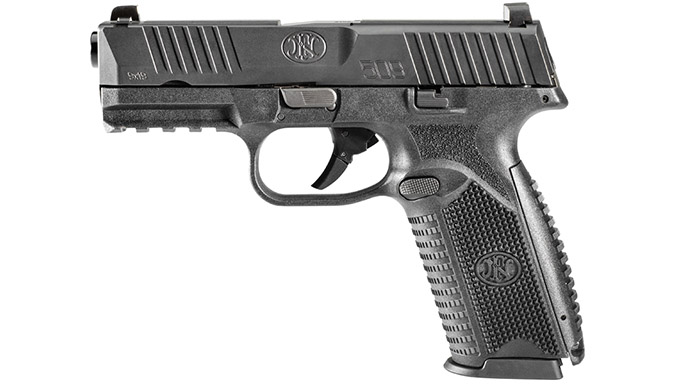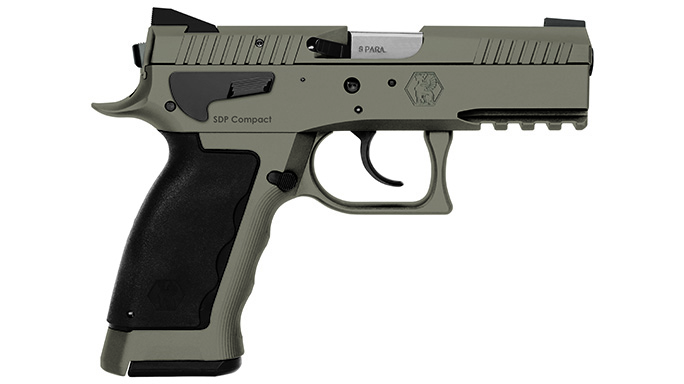By now you’re probably aware that Sig Sauer’s P320 won the U.S. Army’s XM17 Modular Handgun System (MHS) competition to replace the legacy M9 and M11 service handguns—mil-spec versions of the Beretta 92FS and Sig P228, respectively. Starting with the Future Handgun System (FHS) over a decade ago, which merged with U.S. Special Operation Command’s Joint Combat Pistol (JCP) program, the idea was to pick a suitable off-the-shelf replacement. This eventually led to the Army-managed MHS program.
The House Armed Services Committee pushed to cancel the XM17 MHS program and upgrade the M9 instead as a less expensive option. Attempting to appease the MHS specifications while meeting the House’s suggestions, Beretta created its M9A3 pistol upgrade after identifying engineering change proposals (ECPs) under the existing contract. However, shortly after that, reports circulated that the M9A3 had been rejected and the House of Representatives approved $5.4 million to procure 7,106 MHS-approved pistols for testing. Thus, Army Contracting Command released an official MHS request for proposals (RFP) in August of 2015, listing a program value of up to $580 million.
Depending on what source you listen to, there were up to 14 pistols from 12 manufacturers offered as contenders for the MHS program. The testing ended up being a $17 million process to find a replacement. The initial bidders for the contract included Beretta, CZ, Glock, FN, Smith & Wesson and Sig Sauer, among others.
Advertisement — Continue Reading Below
XM17 MHS Program Details
According to the original RFP, “the MHS will consist of the handgun(s), associated ammunition and supporting accessories to include spare parts. Interested vendors will be required to supply all of the items as described under the resulting contract.” Each proposal was to consist of either a two-handgun solution—one full-sized and one compact—or one handgun solution that met requirements for both a full-sized and compact weapon. The Department of Defense dictated that all of the competitors had to have modifiable grips, ambidextrous controls, magazine options and rails. In addition, the Army requested that all of the test firearms have hits on a 4-inch target at 50 meters at least 90 percent of the time throughout the gun’s lifespan.
Other key points included the overall price: “A price reasonableness determination will be made on the total evaluated price which will be used in the performance of a tradeoff analysis.”
- RELATED STORY: Glock vs Sig – The ‘World War III’ for Pistol Fanboys
The idea was to build a gun that could fit the widest possible range of soldiers. According to the initial RFP, “The offeror shall provide in the operator manual a detailed description of the ergonomic aspects of their pistol. This manual shall clearly detail the steps required to make adjustments to trigger reach, pistol grip or any other adjustable components to fit the range of users expected to utilize the Modular Handgun System. Configurability will be evaluated based on ease of reconfiguration, ergonomic accommodation and effectiveness for the 5th to 95th percentile warfighter. The manual should also depict reconfiguration options and instructions to adjust controls from right- to left-handed use at the operator level.”
Advertisement — Continue Reading Below
Finally, “Upon receipt of hardware submission, inspections will be conducted to ensure that the Modular Handgun System candidate has an integrated rail, an external safety mechanism, adjustability for ergonomics (by means of grip inserts, grip panels, front- or backstraps, different triggers, or other means) and be other than single action only. Submissions without these features will not be considered for evaluation.”
These key points make it easier to understand how the Sig P320 won the final bid. There were rumors of the Heckler & Koch VP9 and VP40, Springfield Armory XDM, Taurus PT 24/7 OSS and Walther PPQ M2 being offered as possible contenders, but these aren’t firm. So, without further ado, let’s take a look at some of the major contenders.
Beretta M9A3
Since it was already under contract, Beretta’s first bid was the M9A3 as a parts-compatible improvement on the existing M9, making it a low-cost option. This was rejected seemingly out of hand. While the solicitation didn’t specify against a double-action/single-action (DA/SA) option, language seemed to imply that an always-consistent trigger was preferred, provided it wasn’t a single action. Interestingly, Beretta’s DA/SA design providing a “double-strike” capability on misfired ammunition was a selection point over the Glock 17 in 1985, yet it may have hindered its re-adoption here. More damning was the lack of a compact version of the M9A3, as required, and not really having a modular design. (berettausa.com)
Advertisement — Continue Reading Below
Beretta APX
Beretta also offered the APX, which was designed primarily for the XM17 MHS after the M9A3 was rejected. This is a striker-fired pistol, and the APX also features a removable, serialized chassis and can be modified with different frame housings made of a fiberglass-reinforced polymer. Unlike a Glock, a trigger pull is not required for disassembly, as the user can deactivate the internal striker mechanism. A manual safety, magazine disconnect safety and loaded-chamber indicator are also available upon request. A compact frame module and interchangeable backstraps of varying thickness are also available. In the end, the APX met all of the specifications and preferences for the MHS and is a truly modular design. Its biggest downside is field experience, as it was designed and released in 2016 just in time for evaluation. It has yet to be officially adopted anywhere. (beretta.com)
CZ P-09 MHS
CZ created versions of its P-09 and P-07 for military testing. Based on the CZ series popular in Production/Stock practical competition, the CZ P-09 holds 19+1 rounds of 9mm ammo and features a double- action-only (DAO) trigger with a bobbed hammer. The more compact P-07 was also considered, and shooters could swap out both models’ backstraps. The designs featured manual safeties, but there is no indication these pistols had truly modular grips or frames. While not explicitly forbidden, the DAO trigger was certainly not an MHS requirement and not favored. In the end, CZ ended up choosing to not formally enter the XM17 MHS competition. (cz-usa.com)
FN 509
To meet the rigorous standards of the XM17 MHS solicitation, FN entered an updated version of its FNS-9 Compact. The resulting FN 509—now available on the civilian market—is a striker-fired design without a manual safety. It comes with three-dot luminescent sights, an external extractor that also serves as a loaded-chamber indicator, a cold-hammer-forged barrel with a recessed target crown and a polymer grip frame that accepts interchangeable backstraps. The FN 509’s grip is also highly textured for a secure hold, and the slide stop and magazine release are both ambidextrous. (fnamerica.com)
Advertisement — Continue Reading Below
Glock 19
Glocks have a long, well-earned reputation. They’ve been fielded successfully around the world since the 1980s. The Glock 17 was first considered during the last U.S. selection in 1985. Since then, many militaries and law enforcement agencies have adopted the handgun. Glock has multiple variants in full and compact sizes with good parts compatibility and a well- established track record. The latest iterations have interchangeable backstraps, but the smallest unit reduces the trigger distance from the standard size frame by approximately 0.08 inches, only making the distance between the front and backstrap area on the grip slightly shorter. Besides not really being a modular design, its downfalls are a lack of a manual safety from the factory and a requirement to pull the trigger for disassembly. While a non-issue for reasonably skilled handgunners out there, this is not quite a valid descriptor for some DoD personnel. (us.glock.com)
Smith & Wesson M&P9
The M&P series has become a popular choice among law enforcement officers and in practical competition circles. The polymer-framed, striker-fired design is fully ambidextrous, has a Picatinny rail for accessories like lights and lasers, an optional manual thumb safety and interchangeable backstraps to fit a wide variety of hand sizes. While both Smith & Wesson and its M&P line have a solid track record, the company’s XM17 MHS offering isn’t really modular. As a publicly-traded company, Smith & Wesson filed its removal from the XM17 MHS with the Securities & Exchange Commission but didn’t go into detail as to why. (smith-wesson.com)
Sphinx SDP Compact
Part of the Swiss-based KRISS group, Sphinx included subcompact and compact versions of its DA/SA SDP pistols, which are similar to the CZ 75, for the XM17 MHS solicitation. Using a hybrid metal/polymer frame, the SDP MHS offering had inserts to change the frame size as well as ambidextrous controls. While the SDP has had some successful use in law enforcement and military applications, it isn’t as widely used in the U.S. (kriss-usa.com)
Advertisement — Continue Reading Below
STI-Detonics STX
Detonics Defense partnered with noted competition pistol maker STI to offer the STX. The STX was one of the few truly modular designs offered, and one of the only pistols with a completely metal chassis that accepts four different-length barrel/slide assemblies as well as a full-sized or compact grip. Detonics and STI designed the frame around the U.S. Army’s specified anthropometric grip geometries. The firing control kit is modular and striker-fired, maintaining a single consistent trigger pull without being a true single action, as per the solicitation. However, the unit requires armorer support for replacement. While the pistol had been considered, the STX was withdrawn from the competition without explanation. (stiguns.com)
Sig P320
Sig’s P320 was one of the few truly modular designs, and it seems well tailored for the XM17 MHS specifications. The serialized fire control unit is technically the firearm according to BATFE rules, and it can be swapped into any small, medium or large grip module and then topped with any slide/barrel assembly, including those of a different caliber; 9mm, .40 S&W, .357 SIG and .45 ACP versions are currently available. The fire control unit can also be set up to use two different trigger systems, including one with an integral trigger blade safety, and the trigger has a short, consistent and crisp break.
The controls are ambidextrous, and the interchangeable parts can all be assembled and field-stripped in the field without any tools or pulling the trigger beforehand. The Army ultimately selected full-sized and compact 9mm variants in Flat Dark Earth with manual thumb safeties.
Advertisement — Continue Reading Below
Around since 2014, the P320 has been adopted by some law enforcement agencies. Obviously, the Department of Defense already uses Sig’s M11/P228 pistols. To top it off, the company was rumored to sell the units to the military for just over $200 each, though this might only be for the fire control unit.
Whether by design or testing, the P320 fully met the MHS requirements and is offered by a company with a long DoD track record. While the P320 is new, it had already seen service with some agencies prior to the MHS. Time will tell if it proves as durable as some of the other options. All of the XM17 MHS designs had promise, with many of them having solid field reports. I’d share agreement with anyone claiming their pet choice would have made a good M17, but Sig’s P320 is a solid pick. (sigsauer.com)
This article was originally published in “Tactical Weapons” August/September 2017. To order and subscribe, visit outdoorgroupstore.com.
Advertisement — Continue Reading Below






































